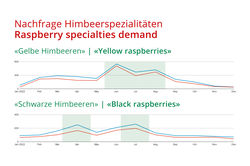 Traditionally, soft fruit plants are delivered to sales outlets and sold off in early spring. Depending on the season, there may or may not be additional deliveries. Using Google data, we show that the demand for certain types of fruit (or the corresponding terms) is sometimes continuous throughout the year or that there is a second peak after spring when the fruit in question is ripe. But can this effect also be demonstrated in specific plant sales? Are we perhaps systematically selling many soft fruit varieties too early? Are we possibly missing out on substantial demand if there are hardly any fresh and beautiful plants on the market later in the year?
Traditionally, soft fruit plants are delivered to sales outlets and sold off in early spring. Depending on the season, there may or may not be additional deliveries. Using Google data, we show that the demand for certain types of fruit (or the corresponding terms) is sometimes continuous throughout the year or that there is a second peak after spring when the fruit in question is ripe. But can this effect also be demonstrated in specific plant sales? Are we perhaps systematically selling many soft fruit varieties too early? Are we possibly missing out on substantial demand if there are hardly any fresh and beautiful plants on the market later in the year?
The theoretical demand for search terms on Google
Each of us has learned to search Google for specific or combined terms as required. If you aggregate this data and compare it over a year, you should be able to get at least a theoretical picture of the relative intensity of demand. Of course, not everyone who types 'raspberry plants' or 'raspberries' into the search box wants to buy a raspberry plant straight away, but at least it can be concluded that the searcher has a certain interest and that the type of fruit in question is perceived particularly consciously at the time of greatest demand – both of which are important prerequisites for buying plants.
Fruit types with an early demand (according to Google data)
The term 'raspberries' is in demand with a peak in early spring, but also remains relevant in the second half of the year with around 30% of the peak demand.
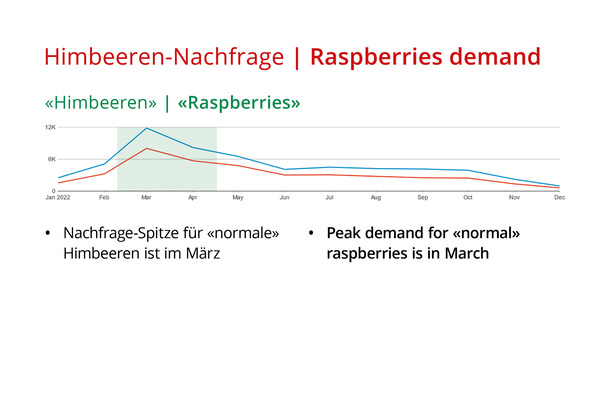
Figure: Demand for raspberries over the course of the year (based on Google data)
Fruit types with a late demand (according to Google data)
The classic shrub berry types gooseberries, currants and blackberries are only in demand late, in June and July. The assumption that the season and ripening time of the corresponding fruit trigger the demand for the appropriate terms is confirmed in the case of blackberries, whose peak demand is delayed by around one month, in line with the harvest time. Blackberries do not ripen in June/July, but mostly in August.
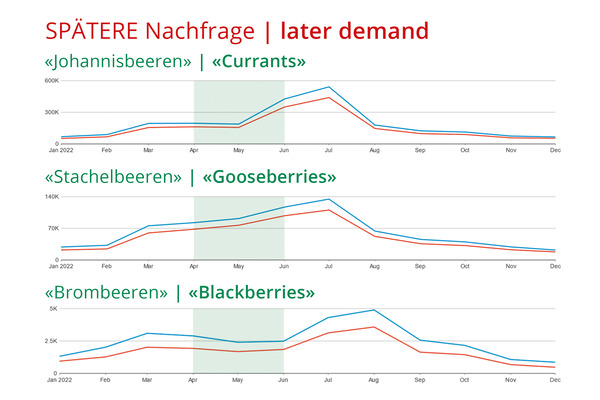
Figure: Some types of fruit have a later peak in demand
Fruit types with two windows of demand (according to Google data)
A second typical pattern is a demand with two peaks, once in the spring and then again in late summer/autumn. In the case of the term 'fruit tree', this certainly has to do with the traditional second planting season in autumn (and of course also with the harvest time of the fruit); in the case of the term 'blueberry bush', which is relatively close to the purchase intention of the plant, the second peak is somewhat earlier, in midsummer, at the same time as both the ripening time of the blueberries and their increased supply in the supermarkets during the summer.

Figure: some types of fruit have not just one peak in demand, but several (in this case there are two)
Fruit species with continuous demand (Google data)
Strawberries, kiwis and fig trees show a continuous demand throughout the season. At least in the case of strawberries and kiwis, the season-independent continuous supply in the supermarkets certainly plays a role.

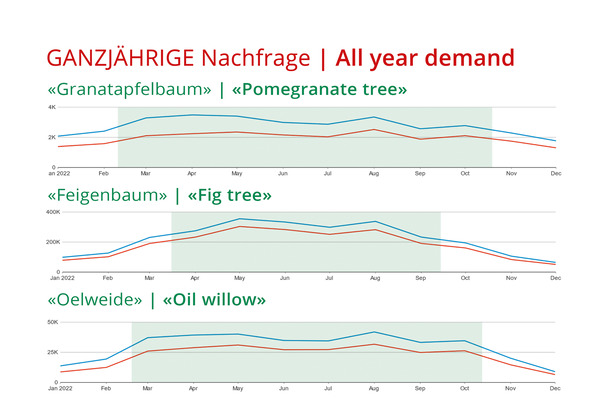
Figure: In addition, there are also fruit species that have a continuous demand over the entire growing season
The actual sales figures at Lubera.com
At our sister company Lubera.com, all products are offered continuously and in a wide selection from mid-February until Christmas. Below we show a selection of evaluations that compare sales in the first half of the year with sales in the second half of the year, and for the best-selling type of berry (raspberries) we show the relative share of sales per month.
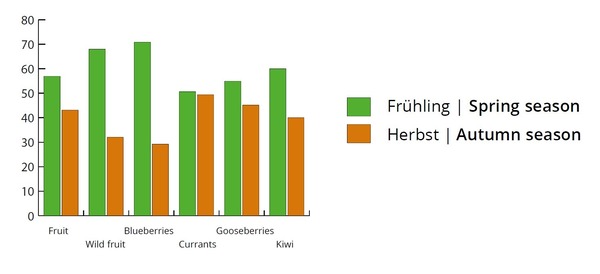
Figure: Comparison of sales figures between the first (spring) and second (autumn) half-years
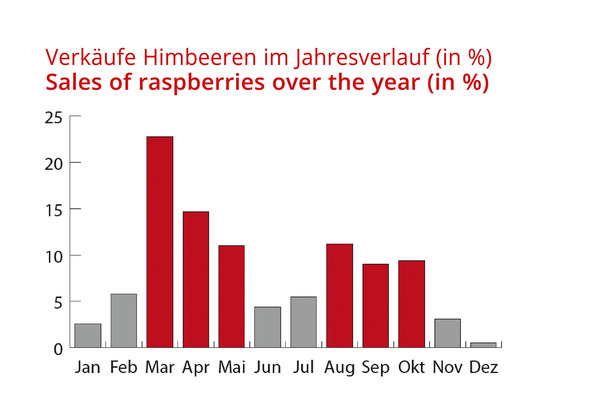
Figure: Raspberry sales figures at a glance - broken down by individual months
The market punishes those who come too early...
Both the theoretical Google figures, which show the demand for certain terms, and the actual Lubera sales figures show that the demand after the spring season is significant for almost all types of fruit, especially for many types of berries. Even for raspberries, the sales figures from May to autumn are significantly higher than in February and April. It is therefore reasonable to assume that physical fruit and especially berry plant sales in stationary retail outlets miss out on a good portion of the natural demand in early spring.
Three hypotheses for better coordination of the soft fruit demand and soft fruit supply
- For core products such as raspberries, it is worth providing a fresh supply of plants all year round. In response to this demand, we often hear that there is not enough visitor frequency at the plants’ points of sale after the season. To a large extent, this argument resembles a 'self-fulfilling prophecy', as without a suitable supply, demand is also stifled...if, for example, only old plants left over from the spring supply are available in the summer. However, DIY stores in particular have a constant stream of visitors who simply need to be made more aware of the current range of berry plants during the 'hors saison'. In the spring, the range of plants on offer here helps to boost hardware sales. And after the spring season, the DIY market frequency could help the plants...
- For plants with a double peak in demand, it could be worth covering the second season with a special offer. Here there is the additional advantage that in July and August the fresh supply could be completely or partially covered with fresh plants produced this year. This leads to lower production costs and could also facilitate promotions.
- If a second wave of supply is planned anyway, this should not only take place in September (after the supposed vacation period) for most soft fruit varieties but already in July and August.
